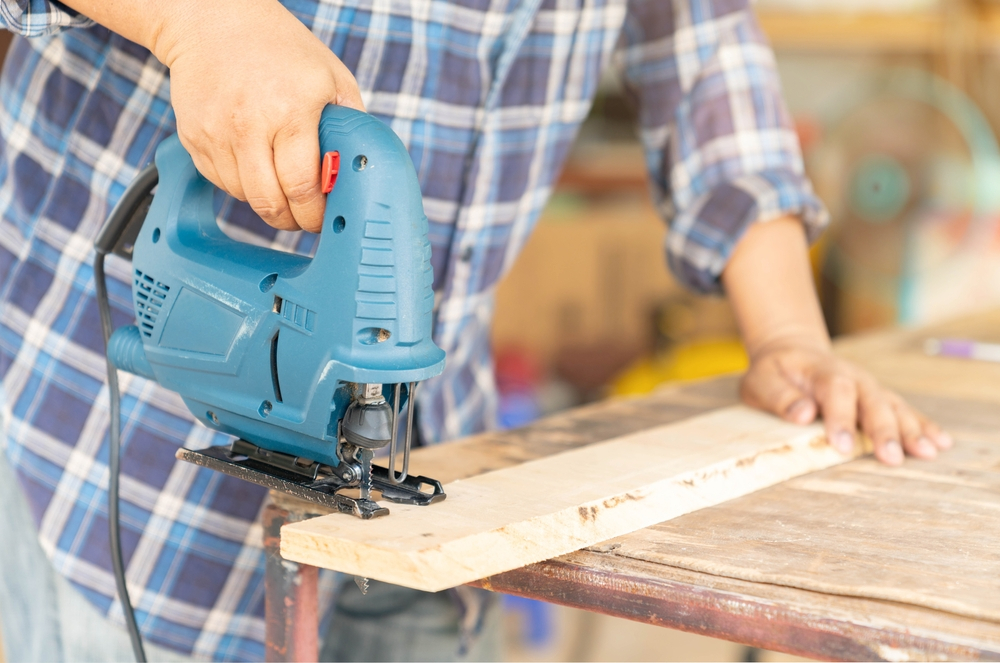A jigsaw is a power tool that is used for cutting irregular shapes, curves, and straight lines in wood, plastic, and metal. It is commonly used in woodworking and carpentry, but can also be used in a variety of other applications such as cutting sheet metal or plastic for artistic or decorative purposes.
Jigsaws are equipped with a narrow, reciprocating blade that moves up and down rapidly to make the cuts. The blade can be changed out to accommodate different materials or cut shapes.
Some important safety precautions to keep in mind when using a jigsaw include wearing protective eyewear and earplugs, as the tool can produce a lot of noise and debris. It is also a good idea to use a dust mask if you are cutting materials that produce a lot of fine particles, such as MDF (medium-density fibreboard).
Contents
10 Steps For Using Jigsaw
- Gather your materials and equipment: Make sure you have everything you need, including the jigsaw, a suitable blade, your materials, protective eyewear, earplugs, and any other necessary tools or supplies.
- Set up your work area: Clear a space that is large enough to accommodate your materials and the jigsaw. Make sure the area is well-lit and well-ventilated, and consider using a workbench or other sturdy surface to support your materials.
- Secure your materials: Use clamps or other restraints to hold your materials in place. This will prevent them from moving or shifting while you are cutting, which can result in inaccurate cuts or even accidents.
- Mark your cut line: Use a pencil or other marking tool to draw a line along the path you want to cut. This will help you stay on track and make more accurate cuts.
- Install the blade: Make sure you have the correct blade installed and that it is tightened properly. If your jigsaw has adjustable speed control, set it to the appropriate level for your project.
- Turn on the jigsaw: Hold the jigsaw steady with both hands and turn it on. Make sure you are wearing protective eyewear and earplugs before starting the tool.
- Begin cutting: Hold the jigsaw steady and use a steady, even motion to follow the cut line. Apply gentle pressure to the tool and adjust the speed as needed to achieve the best results.
- Finishing the cut: Once you have reached the end of the cut line, turn off the jigsaw and carefully remove the blade from the material.
- Clean the jigsaw: Use a dry cloth or compressed air to remove any sawdust or debris from the tool. Be sure to clean the blade and blade guide as well to remove any material that may have accumulated during use.
- Store the jigsaw: When not in use, store your jigsaw in a dry, cool place to protect it from moisture and extreme temperatures. It is also a good idea to unplug the tool and remove the blade to prevent accidental injuries or damage.
Jigsaw Cutting Best Techniques
Jigsaw cutting techniques refer to the methods and approaches used to make precise, accurate cuts using a jigsaw. These techniques can vary depending on the specific project and material being cut, but there are a few general tips that can help improve the accuracy and quality of your cuts.
- Use a straight edge or guide: If you are trying to make a straight cut, it can be helpful to use a straight edge or guide to help you stay on track. This can be especially useful for longer cuts or when working with materials that are prone to warping or shifting.
- Adjust the blade speed: Many jigsaws have adjustable speed control, which can be useful for making fine adjustments depending on the material and cut you are making. For example, slower speeds may be more suitable for softer materials or finer cuts, while faster speeds may be better for tougher materials or thicker cuts.
- Use the right blade: Different blade types are better suited for different materials. For example, a standard wood blade will work well for cutting softwoods, but a metal-cutting blade may be needed for tougher materials. Be sure to select the appropriate blade for your project to ensure the best results.
- Maintain proper blade tension: Proper blade tension is important for making smooth, accurate cuts. If the blade is too loose, it may wander or break, while a blade that is too tight may be difficult to control or may cause the jigsaw to vibrate excessively.
- Use a steady hand: A steady hand is important for making smooth, accurate cuts. Try to maintain a consistent grip and arm position throughout the cut to help keep the jigsaw steady.
By following these tips and techniques, you can improve the accuracy and quality of your jigsaw cuts and get better results on your projects.
Choosing The Right Jigsaw For Your Project
- There are a few key factors to consider when choosing a jigsaw for your project:
- Corded vs. cordless: Corded jigsaws are generally more powerful and have a longer run time, but they may be less convenient to use if you need to move around or don’t have access to an outlet. Cordless jigsaws offer more flexibility, but they may not be as powerful and may need to be recharged more frequently.
- Blade type: Different blade types are better suited for different materials. For example, a standard wood blade will work well for cutting softwoods, but a metal-cutting blade may be needed for tougher materials. Be sure to select the appropriate blade for your project to ensure the best results.
- Power and speed control: More powerful jigsaws are generally better for tougher materials or thicker cuts, but they may also be more expensive. If you will be doing a lot of cutting, it may be worth investing in a higher-powered jigsaw. Many jigsaws also have adjustable speed control, which can be helpful for making fine adjustments depending on the material and cut you are making.
Preparing Your Materials And Workspace
- Before you start using your jigsaw, it’s important to set up your work area and secure your materials. This will help ensure that you can make accurate cuts and minimize the risk of accidents.
- To set up your work area, clear a space that is large enough to accommodate your materials and the jigsaw itself. Make sure the area is well-lit and well-ventilated, and consider using a workbench or other sturdy surface to support your materials.
- To secure your materials, use clamps or other restraints to hold them in place. This will prevent them from moving or shifting while you are cutting, which can result in inaccurate cuts or even accidents. If you are working with larger materials, it may be helpful to use a jigsaw guide or straight edge to help you make precise cuts.
Using The Jigsaw
- Once you have prepared your materials and workspace, you are ready to start using your jigsaw. Here are some tips to help you get the best results:
- Set up your jigsaw: Make sure you have the correct blade installed and that it is tightened properly. If your jigsaw has adjustable speed control, set it to the appropriate level for your project.
- Mark your cut line clearly: Use a pencil or other marking tool to draw a line along the path you want to cut. This will help you stay on track and make more accurate cuts.
- Hold the jigsaw steady: Use both hands to grip the jigsaw firmly, and keep your arms straight to help maintain control. Use a steady, even motion to
Finishing And Maintenance Of A Jigsaw
Once you have finished using your jigsaw, it is important to properly care for the tool to ensure it remains in good working condition. Here are a few tips for finishing and maintaining your jigsaw:
- Clean the tool: Use a dry cloth or compressed air to remove any sawdust or debris from the tool. Be sure to clean the blade and blade guide as well to remove any material that may have accumulated during use.
- Store the jigsaw properly: When not in use, store your jigsaw in a dry, cool place to protect it from moisture and extreme temperatures. It is also a good idea to unplug the tool and remove the blade to prevent accidental injuries or damage.
- Maintain the blade: Regularly check the blade for wear or damage, and replace it as needed. It is also a good idea to sharpen the blade periodically to keep it in good condition.
- Follow the manufacturer’s recommendations: Be sure to follow the manufacturer’s guidelines for maintaining and servicing your jigsaw. This may include lubricating moving parts or replacing certain components on a regular basis.
By following these tips, you can help ensure that your jigsaw remains in good working condition and continues to provide reliable performance for your projects.
Final Note
Using a jigsaw is a useful skill that can come in handy for a variety of projects, including woodworking, carpentry, and artistic or decorative applications. To get the best results, it is important to choose the right jigsaw for your specific project needs, prepare your materials and workspace, and use the tool correctly. By following these steps and taking necessary safety precautions, you can safely and effectively use a jigsaw to make precise, accurate cuts in a variety of materials. Proper care and maintenance of the tool can also help ensure that it continues to perform well for future projects.

